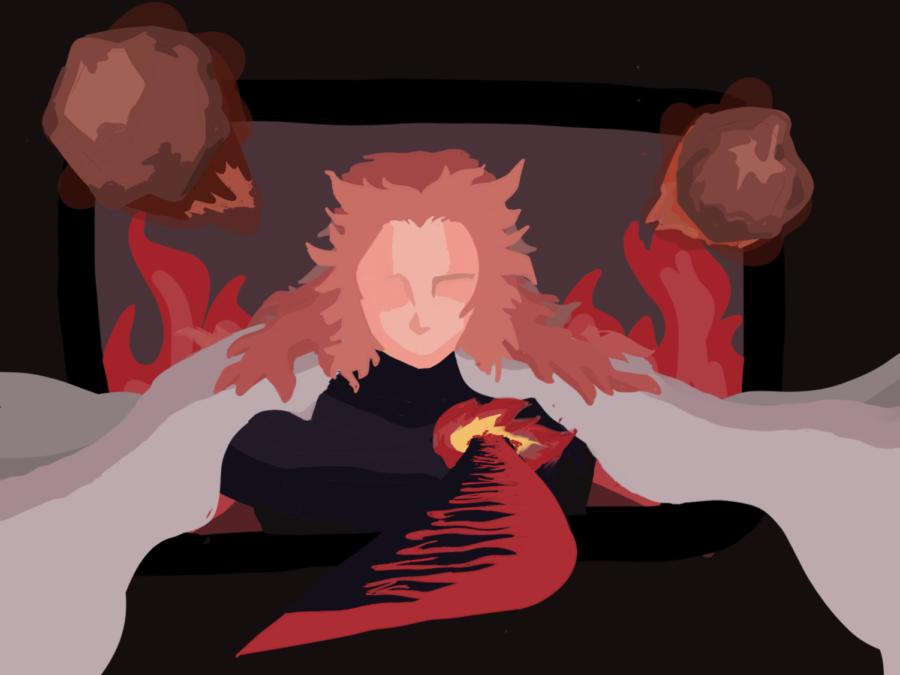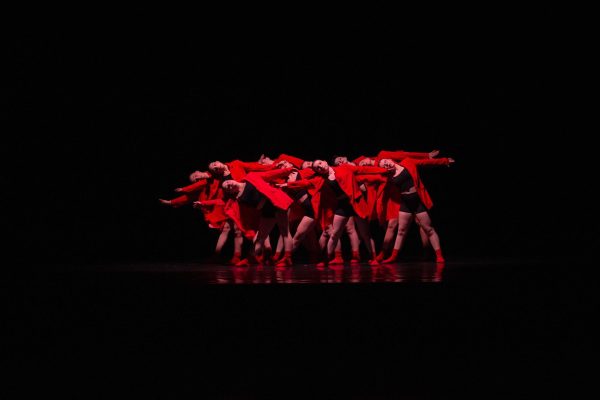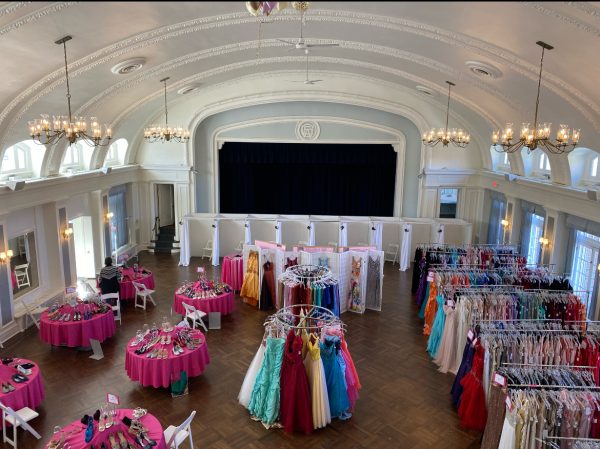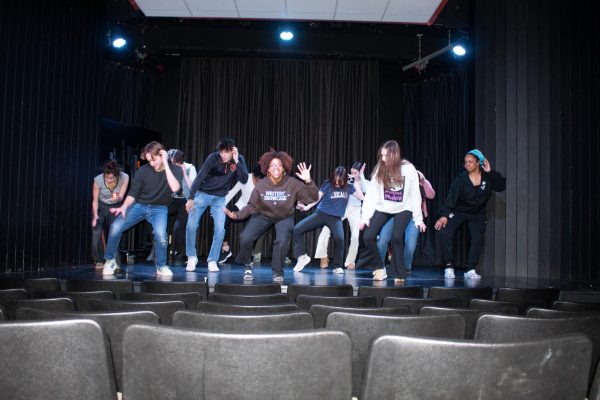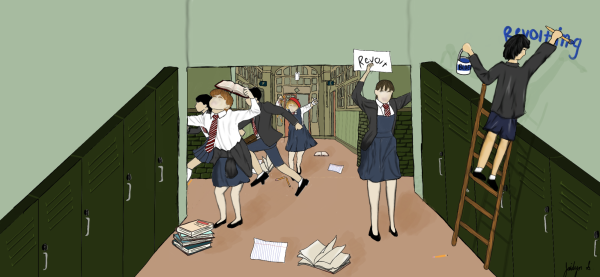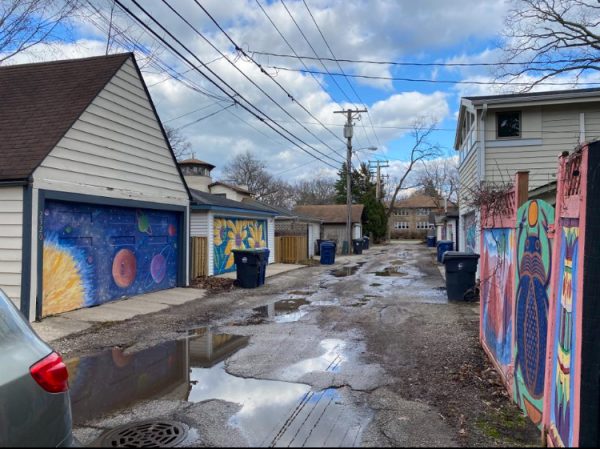Kimetsu No Yaiba (‘Demon Slayer’) Mugen Train arc: more Rengoku
Disclaimer: This article contains major spoilers for both the “Demon Slayer” Mugen Train Movie and Arc.
Set your heart ablaze.
Demon Slayer -Kimetsu no Yaiba- The Movie: Mugen Train was a widely successful and loved film by fans and critics alike, earning $503 million USD in the box office worldwide. From the music, acting, characters, fights, comedy and Ufotable’s stunning animation, everything was perfect.
Although the film was released in the U.S. in April 2021, Ufotable tackled the Mugen Train story again with a retelling before the premiere of season two, causing some fans to scratch their heads as to why such a decision was made.
“I think since [Demon Slayer The Movie: Mugen Train] made a lot of money, Ufotable did touch-ups,” sophomore Sasha Van Den Berg, a manga reader of Demon Slayer and fan of the anime, says. “A lot of studios do touch-ups when they’re going to make a Blu-ray or DVD version of it, so in this case, Ufotable is doing that for the TV adaptation of the movie.”
Anime films can be harder to access than an anime TV series, so a reanimation also allows fans who were unaware the movie existed to watch more easily on certain platforms.
Aside from increasing accessibility and refining the movie for a TV adaptation, there were a few unanswered questions in the Mugen Train movie that were finally answered in the arc, including how Flame Hashira Kyojuro Rengoku arrived at the train and where he received all those bento boxes.
“Flame Hashira Kyojuro Rengoku” fleshes out completely original content that was not even written in the manga. This first episode is a prologue for the movie and opens with the orange sun in the familiar setting of Taisho Era Japan, casting light on the strong-willed and passionate Flame Hashira inside a quaint noodle shop. With the owner of the shop making noodles and pouring in broth with great care as Rengoku wolfs down his serving while yelling, “Umai!” (delicious in Japanese), it goes to show how unmatched the animation is for Demon Slayer, even in such a simple scene.
At the end of season one, Rengoku is sent to investigate a series of attacks occurring in a small village, and the unanswered question of how Rengoku arrived at the Mugen Train is answered in this quaint noodle shop, where he learns from the shopkeeper that 40 passengers aboard the Mugen Train disappeared. Strongly believing that the train has to do with the attacks, Rengoku sets out.
While the episode is lighter in action than episodes from the rest of the arc, the fight scene between Rengoku and the demon that was suspected to have caused the disappearance of the 40 passengers was breathtaking. With Rengoku’s immense speed and his move, Flame Breathing, First Form: Unknowing Fire, Rengoku emerged victorious with his sword in hand, saving two bento vendors, a girl named Fuku and her grandmother, both of whom Rengoku met earlier to question about the attacks.
Rengoku later sensed the lingering scent of a demon, revealing that the demon he killed was not strong enough to kill forty humans, and the demon in question had to be a more powerful one responsible. With this new information in mind, Rengoku finally boards the train after purchasing all the bento boxes Fuku and her grandmother had to offer, which answers question two.
Episode one ends with our favorite main characters Tanjiro Kamado, Nezuko Kamado (hidden in Tanjiro’s box), Zenitsu Agatsuma and Hashibira Inosuke from the Demon Slayer Corps, who were also sent to investigate alongside Rengoku to protect humanity from the demons that lurk on the train. This is where the events of the Mugen Train begin in the next six episodes.
While the rest of the arc is a retelling of the movie, the Mugen Train arc works better as TV episodes in a multitude of ways that surprisingly don’t bore the viewer like many thought it would by doing a recap of the film.
In terms of the similarities, the animation was gorgeous as always and the plot of the movie did not change, staying true to the manga.
In terms of the differences, the soundtrack composed by Yuki Kajiura changed, set a different tone and Japanese pop/rock singer LiSA sang a new theme song than she did for the movie “Akeboshi,” as well as an ending theme, “Shirogane.” Both new songs successfully match the story of the anime with a serene but deep melody.
“Overall, I felt the arc was mostly the same as the movie, but it was less rushed from the movie,” sophomore Ava Russell, another fan of Demon Slayer, says. “I felt that [the arc] spent more time on each character and each setting.”
The Mugen Train film was indeed beautiful, but it was inconsistent at some points, especially since it was an adaptation of 17 chapters from the manga, making it difficult for the film to not feel rushed.
The movie is essentially divided into three acts. The first act sees all four boys (Tanjiro, Inosuke, Zenitsu, and Rengoku) put to sleep by the dream demon, Enmu, on the train, falling deeper into their dreams in hopes of being eliminated. The second act is a battle against Enmu on top of the moving train, and the third is the duel between Rengoku and a powerful demon named Akaza.
These three acts meshed more awkwardly in the movie since time was limited, and a few scenes seemed to appear randomly—for instance when Akaza appears. Putting these three acts together for a TV adaptation restored the pacing of the manga, added a definitive cutoff for each act by allowing only two episodes for each act, and helped to ease the pain of Rengoku’s tear-jerking death by allowing more time.
“Kyojuro Rengoku stood out to me the most,” sophomore Jack Banks, an avid anime watcher and Demon Slayer fan, says. “I think it was his loud personality, but he really seemed proud of himself, and that intrigued me. It also felt like he was in the spotlight for most of season two compared to any of the main characters from season one.”
In addition to the Mugen Train Arc finishing, season two of Demon Slayer will be released soon, set in Japan’s entertainment district with the appearance of a new demon.
“There will be a few character pop-ups from Tengen Uzui; Shinobu, the main villain, [and] Muzan Kibutsuji is also expected to make an appearance, while another villain, Daki, will be voiced by Miyuki Sawashiro,” Banks says.
At first, the red-light district seems like an odd choice for a setting but is incredibly relevant to Japan’s history.
“[The Entertainment District Arc] will bring to light what goes around there with the fantastical twist of there being a demon lurking,” says Van Den Berg. “It’ll be really interesting to see how it works from an outside perspective where you might not have heard of these before, or only seen Westernized versions of it.”
If you’re all caught up on Demon Slayer and have seen season one, all seven episodes of the Mugen Train Arc are available to watch on both Crunchyroll, Funimation and Hulu. The beginning of Demon Slayer Season Two: Entertainment District Arc is also now available to watch, starting with an hour-long episode for its premiere on both Crunchyroll and Funimation.
Your donation will support the student journalists of the Evanstonian. We are planning a big trip to the Journalism Educators Association conference in Philadelphia in November 2023, and any support will go towards making that trip a reality. Contributions will appear as a charge from SNOSite. Donations are NOT tax-deductible.


